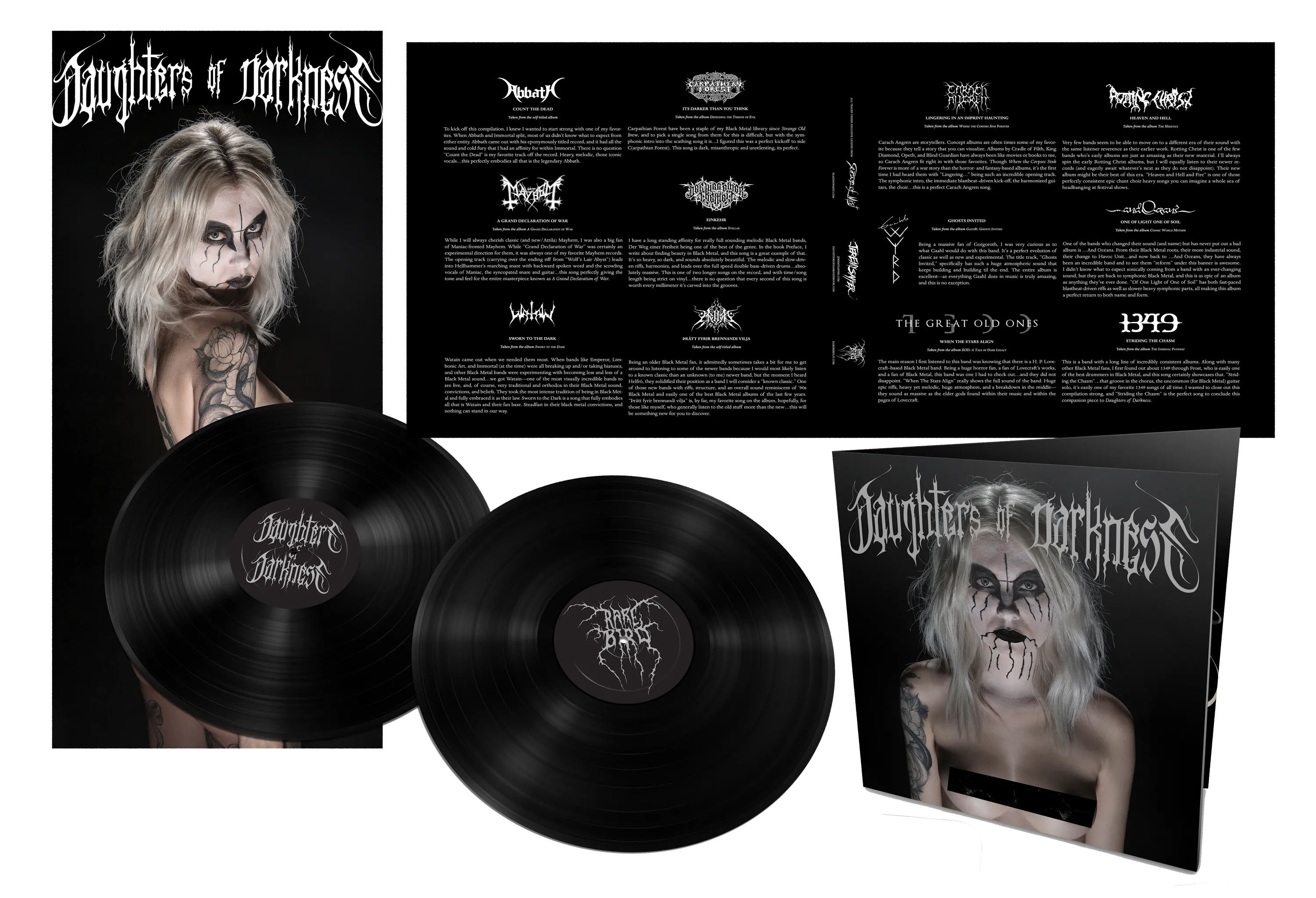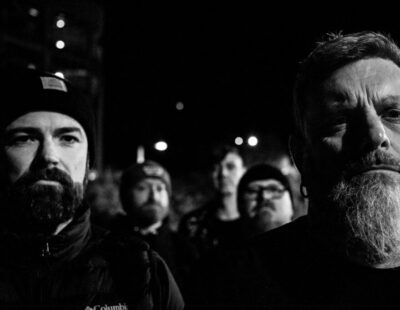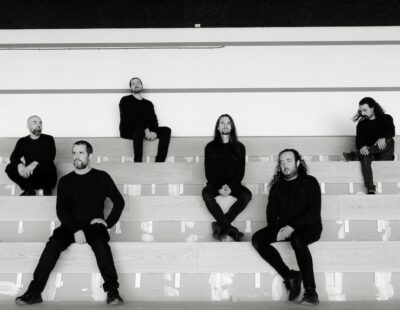
If you’re reading this, you’ve either knowingly or unknowingly enjoyed Jeremy Saffer‘s photography. Saffer has photographed heavy metal musicians for two decades, starting with live snaps and thriving with studio portraits. Whether it’s Behemoth or the Misfits or Shadows Fall, Jeremy Saffer’s discerning eye has helped define visual representations of metal. Saffer’s extreme metal inspirations bleed into his fine art photography as well. His new photo book Daughters of Darkness compiles a project a dozen years in the making: photographing models wearing nothing but corpse paint.
Daughters of Darkness will appeal to those who devoured the vamperotica of early ’90s black metal imagery. With an introduction by Lamb of God’s Randy Blythe and a forward from Cradle of Filth founder Dani Filth, it’s over 280 pages of striking imagery and tasteful nudity. In the interview below, Decibel shares some images that pass the kinda-SFW community guidelines. Special editions of the book also include a vinyl compilation from Season of Mist artists selected by Jeremy Saffer himself. The vinyl boasts grim cuts from Abbath, Mayhem, Rotting Christ, Carpathian Forest, and many more. Scroll further for the interview with Jeremy Saffer and play the Daughters of Darkness playlist as you peruse his bewitching photographs.
Decibel Magazine interview with Jeremy Saffer
When did you first realize your passion for photography and heavy music?
Jeremy Saffer: It’s my first time really thinking about this specifically, but I’ve been into metal since I was about 10. Starting with Metallica, Megadeth, Slayer, Pantera, then getting into the more extreme stuff. I always had a point and shoot camera on me when I would go to shows and go on trips. I never really realized how young I was when I was taking pictures and listening to metal because those two things never really crossed paths until I was about 15.
When I was 15 and 16, I was in bands opening up for bigger bands and would always take photos of the bigger bands to show off. A local promoter (Scott Lee) saw me shooting shows and had me start shooting all of his shows. That quickly snowballed into shooting shows for a bigger company he worked with called Massconcerts. They run the Worcester Palladium, Hartford Webster Theater, and also do shows at various other venues as well. So by 16 or 17 I was shooting shows almost every weekend, and by 18 I was shooting shows more than playing them.
I had gone to Berklee School of Music for music production and engineering and ended up miserable at Berklee. I hated it. I wanted to shoot shows. So after two semesters of misery, I spoke with Scott. I told him I didn’t know what to do. It’s not a great place to be in when you’ve spent every day since you were 9 years old dreaming of going to Berklee and playing music. Then you get to this place where your dreams become a nightmare and you feel like you’re suffocating and can’t do anything about it. Luckily Scott simply said, “Well, what do you want to do?” I said, “Take pictures.” He just smirked and said, “DO THAT!” And those two words, that conversation, changed my life. I never thought of taking up photography as a career; it was always something I did to see the bands I liked, something I did for fun. So I put down my guitar, picked up a camera full-time, started touring, and that’s really what got my career started.
I finished up a summer tour, and enrolled in a 10 month intensive photography school. Admittedly, I had no idea what I was doing beyond basic photographic knowledge. I learned everything I could about lighting and photography; even got my first magazine cover (Mastodon on Metal Maniacs) while in photo school. Then I jumped right back on tour the next summer, but started doing more portrait work for magazines, album covers, and merch. That’s sort of how it all started.
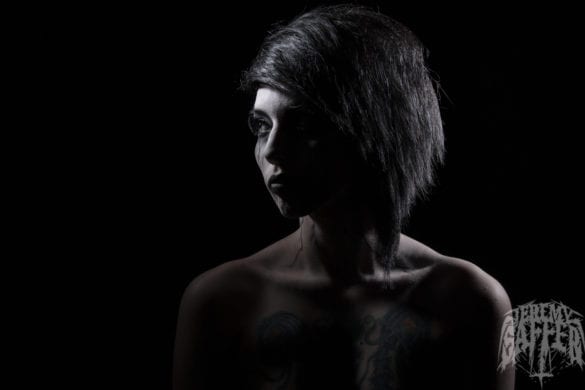
What were your first impressions of corpse paint, and what appealed to you about the imagery?
JS: I always loved dark imagery. I grew up on horror movies, dark photography, and creepy, spooky things. I first encountered corpse paint in the early ’90s when Mayhem got picked up by US press. But prior to that I was always a big fan of King Diamond and his aesthetic. So I wanted to check out another band donning face paint, albeit differently. The first black metal album I heard was Cradle of Filth’s Cruelty and the Beast, and after one spin of that album my affinity for black metal rocketed past any other genre of metal and left them all far behind. I started with Cradle and Immortal and immediately got every Cradle and Immortal album I could. I also tracked down black metal video and CD comps which lead me to some of my favorites like Satyricon, Diabolical Masquerade, Limbonic Art, Emperor, etcetera.
I was well versed with Cradle’s imagery of romantic vampirism; the fine art nude imagery they incorporate in their imagery and merch. I always love imagery that pushes the envelope, so to speak. So having every piece of black metal merch that fit that description was a necessity to me. Bands like Marduk, Cradle, Satyricon, Rotting Christ, Samael, Immortal. I had to have every shirt I could get. So I would go to the local record store (Music Outlet in Enfield, CT) and flip though the albums looking for anything similar to what I already knew. If I saw an album cover with a nude woman in nature, or in an occult setting with corpse paint and blood I would buy the album. That’s how I really discovered so many black metal and doom bands such as Tristania, Theater of Tragedy, Mactatus, and The Sins of Thy Beloved. So I would blindly buy these albums not knowing who the band was. Nine times out of ten they were incredible bands and ended up being some of my favorites for years to come. I was always drawn to that imagery, and to the duality of beauty and beastly darkness.
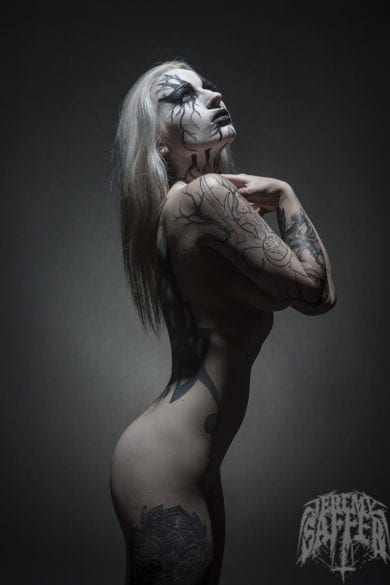
What inspired the Daughters of Darkness project? The scope of the project seems enormous.
JS: The way it sort of started was not intentional by any means. My friend Karim was doing a black metal clothing line and wanted to do a rip on Pulp’s This is Hardcore album cover, where there’s a nude blonde woman with red velvet. I recreated the shot with a nude woman in corpse paint for a “This is Black Metal” t-shirt. After shooting that specific shot, the model (who is also an avid black metal fan) and I decided to shoot more. White background, black background, every type of lighting we can think of. Outdoors, in the creepy basement of my studio; we shot for hours and loved it.
That shoot really triggered a few things all at once. At the time (and still today) I mostly shoot bands for album covers, magazines, promo, and merch. Completely separately I photograph fine art nude portraits of women for art books, galleries and exhibitions. This was the first project that combined the two things I do the most. It also brought me back to that iconic black metal and doom imagery that would have me buying albums based on the art alone.
So after this shoot I decided I should do a series with it, maybe 10 shoots, and see where it goes. About a year later I was at least 50 shoots deep into this project and decided to do a collection of sorts, maybe a calendar. So I did put out a calendar in 2012, which did well. But I kept shooting this project beyond that as I loved shooting it. I was constantly getting contacted by models and friends who are black metal fans and wanted to shoot for it. It sort of just kept going and going and going.
About 5 years in I knew I had wanted to do a book with it, however I was having no luck getting it published. Publishers who put out fine art nude books wouldn’t touch it because of the corpse paint; too niche, too scary, too evil. When I gave up on that, I reached out to record labels, clothing lines, anywhere that was black metal themed. They wouldn’t touch it because of nudity. So I sort of just kept shooting, and every year would reach out to publishers with new images from the project and get a bunch of no’s and try again the next year. About 2 years ago I stopped shooting the project. I got a bit disheartened when a few places I thought would be interested in publishing it said no, and figured I would likely self publish it like I did my last two books. So I was thinking, maybe Kickstarter? How do I do one of those? And I brainstormed but got really busy with music photography work and didn’t have a lot of time to dedicate to the project.
Last year I did a photo shoot for Nekrogoblikon, who famously have a Goblin mascot, John Goblikon. I shot for their book which is a self-help book by John Goblikon and it’s incredible, so funny. The publisher was Rare Bird who I recognized, as they had published Keith Buckley (Every Time I Die). After finishing up the photo details of the Nekrogoblikon book, I mentioned my corpse paint project, and rather than getting a slow reply or a “we will get back to you, we will let you know” I immediately got a “YES! Lets do it!”
In February I met the owner for the first time, when I walked into the office he was wearing a Satyricon hoodie, and we talked black metal for an hour or two before even talking about the book. That’s how I knew I found the right publisher. They are as excited about this book as I am, they wanted every detail I wanted to come to fruition from the size, look, paper, everything! This book is exactly how I wanted it presented. I could go on and on about how incredible Rare Bird are. The best part of this project is its as much a victory for the models as it is for me. Some had shot for this 12 years ago and haven’t seen the images yet. So for this to finally finally come to fruition is such a massive achievement not just for me, but for them as well.
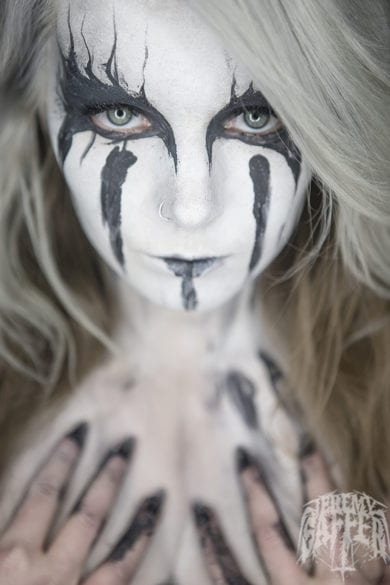
Some of the musicians I’ve interviewed talk about corpse paint like it’s a spiritual out-of-body experience. How did your models talk about wearing corpse paint?
JS: One of the things I really love about this project is that all the models did their own corpse paint designs. Every model who shot for this is a fan of metal, mostly black metal fans. Everyone was well-versed with corpse paint and knew what they wanted to do.
Most of these models I have worked with many times or are close friends or both. So seeing the corpse paint sort of transform who they are a little bit (or a lot) in terms of their posing, their attitude, their general demeanor was incredible. It seemed to be so empowering and so special and different to anything else I’d shot with them before. One specific shoot comes to mind: As soon as actress Caroline Williams (Texas Chainsaw Massacre 2) had the corpse paint on, she was a different person and she did not break character from who she became until the make up was off. It was unreal. A few models in the book are also in bands who wear corpse paint, which is really cool to have them involved.
I think one of the most interesting things in these shoots is so many of these models became their own visual representation and embodiment of black metal. When models are asked about the project they talk about it being empowering, and they talk about the duality of evil and beauty. The vision and direction of the book is very much shared with those involved and within the pages of the book.
Because so many laws and rules are created and enforced by puritans, we’re only permitted to share the Safe-For-Work images with this interview. As a photographer, what’s the significance of nudity to you and how it’s perceived by the public?
JS: How insane is it that nudity is looked at in any negative light hundreds and hundreds of years after it had been looked up to in artwork? If you think about classic art you think of nudity in at least some of it. The human form has long been a study and subject in art since art first came into existence. So to see it looked down upon is just silly in my opinion.
But here’s the thing about art: it’s subjective and really up to the viewer to decide what it is. You have a fine line in nudity between what is art, what is porn, and what is erotica; what is acceptable, what is not acceptable.
I personally never got into photographing erotica/porn, but there’s certainly plenty that is art. And there is plenty of fine art nudity that could be considered porn. It’s a weird line that is drawn by each individual viewer. For me, I think the human form will always be a study and subject of every art medium in every different point of view possible. From artistic, exploitative, comedic, dramatic, and any way it could be created and presented.
Fine nude art was something I was always drawn to. The art of Luis Royo, Boris Vallejo, Julie Bell, and Joseph Linsner. The photography of Herb Ritts, Helmut Newton, David LaChapelle, and so on. I think it will always have a place in what I do.
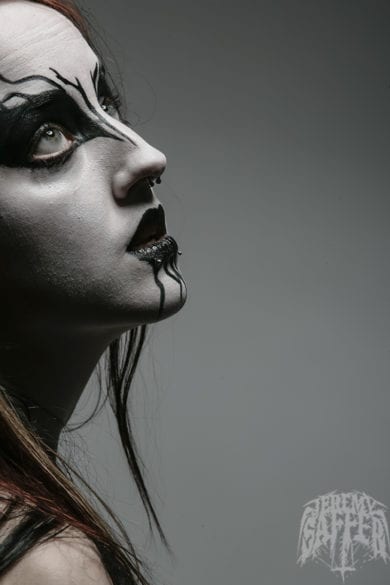
The book is accompanied by an amazing soundtrack from Season of Mist. Do you ever incorporate music into your photo shoots as a way to set mood or atmosphere on set?
JS: There is never a time music isn’t playing while I shoot in studio. For Daughters of Darkness, it was always black metal. Sometimes a mix or compilation, sometimes an album or a few. I think music is important to get into a photo shoot especially when it’s in studio and it’s dead silent aside from the photographer and the subject. When shooting on location, obviously that’s not always possible.
As for the Daughters of Darkness vinyl, what a dream come true. I grew up on so many black metal comps that got me into bands I didn’t know, so as a kid you would imagine putting together your own comp. I’m sure every music fan has made playlists, or burned mixed CDs with MP3s, or made mix-tapes. I made so many black metal comps of sorts for myself, and years later I get to do it for real.
I have a great working relationship with Season of Mist, having photographed many of their bands over the years. So I reached out to them asking if they would be interested in doing a vinyl comp with the publisher, who would put it out and give it away free with the book. They gave me the keys to their archive and let me choose the bands I wanted and the songs I wanted. So I got to pick my favorite songs by some of my favorite bands which was unreal.
The book isn’t singular in style: there’s fashion, glam, in studio, on location, dark lit, bright lit, emotionless, fully emotive. There’s everything in the shots. And the vinyl is no different: it has symphonic, thrash, blackened death, raw, atmospheric, classic, new, and every subgenre of black metal on there. It’s a perfect companion-piece to spin while flipping through the book.

Your book shares a title with a 1971 vampire film that was a big inspiration for Cradle of Filth and other gothic/black metal bands. What are some other vampire films you’d recommend for the Halloween season?
JS: What an incredible movie that is, too. The book actually, and honestly, isn’t named after that classic. It comes from my favorite black metal band, Immortal. They have an amazing album, Sons of Northern Darkness. I thought, if they are the sons of darkness, who are the daughters? These are the Daughters of Darkness! So that’s where the title comes from though.
That said, there is no question I am a massive fan of vampires in all art, and even more so Bathory (the Countess and the band, respectively). That’s why Cruelty and the Beast is one of my favorite albums of all time. Shame they haven’t done a great Bathory movie yet. But the book The Blood Countess by Andrei Codrescu is amazing, if only someone would adapt that to film.
The best vampire movie of all time in my opinion is Bram Stoker’s Dracula (1992) with Gary Oldman playing the Count. What a beautiful movie. Bloody, gory, the best script, the wardrobe, the cast, set pieces, how anti-religion it is. It’s a perfect movie.
Other great vampire movies: From Dusk ‘Til Dawn is an amazing, great take on vampires with a killer soundtrack. Nightwatch is one of the most amazing and interesting takes on vampires. What We Do in the Shadows is a great comedic take on vampires, as is Blood Sucking Bastards. Lost Boys is of course a must. I love when Cory kills a vampire with a record in Lost Boys: The Thirst and says “VINYL SHREDS!” If you want a fun action vampire movie, Blade is great. Innocent Blood is a great vampire comedy. If you have a younger crowd, the Hotel Transylvania series is really good, as is Dracula: Dead and Loving It (Mel Brooks spoof on the ’92 Dracula). And lastly, Tim Burton’s Dark Shadows is excellent. But what movie with Alice Cooper and Depp isn’t excellent?

After Daughters of Darkness is released, what do you have planned for the rest of 2020 and beyond? I imagine like most collaborative in-person mediums, the pandemic has impacted photography quite a lot.
JS: I am basically out of work until touring resumes. I think the live entertainment world was hit the hardest with the pandemic, in that it will be the last thing to really come back. So until bands resume touring, I won’t likely be shooting many bands, which is the majority of my career. But in the meantime, I have been testing new equipment. I recently switched to Leica from Canon. I started a Patreon where I post these test shoots I’ve been doing (safely distanced or with my partner who is a model) as well as digging up past photo shoots and breaking down every aspect of them from the lighting, technical details, behind the scenes, and the story behind the shoot.
The next thing I will want to do is a new band photography book that doesn’t just show the final published images, but shows the behind the scenes and the stories behind the shoot. Many are funny, interesting and some are certainly frustrating. I recently started shooting corpse paint again and I’m not sure what the end game of that will be beyond galleries. But I am hoping, fingers crossed, that Daughters of Darkness does well enough to warrant a sequel. Beyond that, just like most of us in the music world, I am just waiting for the world to start again.



